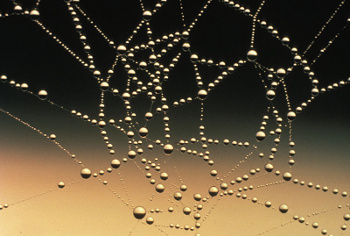Scorpion Windbreakers
February 3, 2012
The biggest problem I faced when I was working in
industrial research and development was the lack of time to properly optimize a
material or
process. As soon as something worked, it was good enough for the marketing people.
Nature, on the other hand, has had millions of years to optimize her materials and processes using
evolution by
natural selection. The performance of many things in nature evoke the envy of today's
materials scientists.
This idea, that naturally engineered materials work exceptionally well in certain applications, has led to the scientific field of
biomimetics. Biomimetics is the study of the structures and functions of
natural organisms as models for materials and devices. I wrote about biomimetics in several previous articles (
Computational Biomimetics, January 17, 2011,
Fog Water Harvesting, December 2, 2010 ,
Control Freaks, October 19, 2010 and
Nano-Clay Composites, October 8, 2007).

A material worth emulating. Spider silk has nearly the same tensile strength (1.3 GPa) as high grade steel, but at a fifth the density (1.3 g/cc).
(U.S. Fish and Wildlife Service photograph, via Wikimedia Commons)
Deserts have considerable challenges to
life, for which nature has provided solutions. Desert animals have developed the means to
scavange and retain water,and to
locomote on sand. Desrt
sand is menacing in other ways.
Sandstorms will pummel unprotected desert organisms, perhaps leading to their early demise, and
extinction of their
species.
A team of scientists, led by Prof. Zhiwu Han, from the Key Laboratory of Bionic Engineering,
Jilin University,
PRC, has investigated an
adaptation of the desert
scorpion,
Androctonus australis (
Arthropoda, Arachricla,
Scorpionida,
Buthidae) that protects them in sandstorms; specifically, from the
erosive action of high speed sand.[1-2] Their research was published in a recent issue of
Langmuir.[1]
This species of scorpion has an
exoskeleton composed of
chitinous cuticle that's textured with a fine structure that directs the flow of sand past their bodies to prevent erosion. Since solid particle erosion is an important factor in the failure of
pipes,
turbine blades,
helicopter rotors,
rocket engine nozzles and other devices, a study of the scorpion exoskeleton could lead to techniques to prevent damage of such mechanical components. Texturing of surfaces would be a less expensive alternative to using more resistant materials.[1-2]

Laser profilometer scan of a scorpion's back.
Portions of the legs are also seen in this image.
Image courtesy of Han Zhiwu, used with permission.
The Jilin University scientists used
laser profilometry to measure the fine-scale contours of the scorpion exoskeleton. Interestingly, they were able to purchase the scorpions at a pet store. They used
computer models of
computational fluid dynamics to optimize the patterns they found, and they produced these on test surfaces. They then tested these patterned surfaces compared to smooth surfaces in an erosion apparatus.[1-2]
Their results showed that a parallel array of small grooves, set at a 30° angle to the flow, gave steel surfaces improved erosion protection over smooth surfaces, as can be seen in the figure.[1]

Erosion rate comparison of smooth and grooved surfaces.
These data are in units of (10-4gram/m2/sec)
(Data from Ref 1)
The Jilin University team found the secret of the desert scorpion's protection from sand-blasting damage. This research gives materials scientists and mechanical engineers a method to design biomimetic functional surfaces to mitigate surface erosion and the resultant damage and failure in helicopter rotors, rocket motor nozzles, turbine blades, piping, and other systems.
References:
- Han Zhiwu, Zhang Junqiu, Ge Chao, Wen Li and and Luquan Ren, "Erosion Resistance of Bionic Functional Surfaces Inspired from Desert Scorpions," Langmuir, Article ASAP, DOI: 10.1021/la203942r, December 30, 2011.
- Michael Bernstein, "Scorpions inspire scientists in making tougher surfaces for machinery," American Chemical Society Press Release, January 25, 2012.
Permanent Link to this article
Linked Keywords: Industrial research and development; material; process; nature; evolution; natural selection; materials scientist; biomimetics; natural organism; spider silk; tensile strength; steel; density; U.S. Fish and Wildlife Service; Wikimedia Commons; desert; life; Namib Desert beetle; sidewinding; sand; sandstorm; extinction; species; Jilin University; China; PRC; adaptation; scorpion; Androctonus; australis; Arthropoda; Scorpionida; Buthidae; erosion; Langmuir; exoskeleton; chitin; cuticle; pipe; turbine blade; helicopter rotor; rocket engine; nozzle; laser; profilometer; profilometry; computer simulation; computer model; computational fluid dynamics.